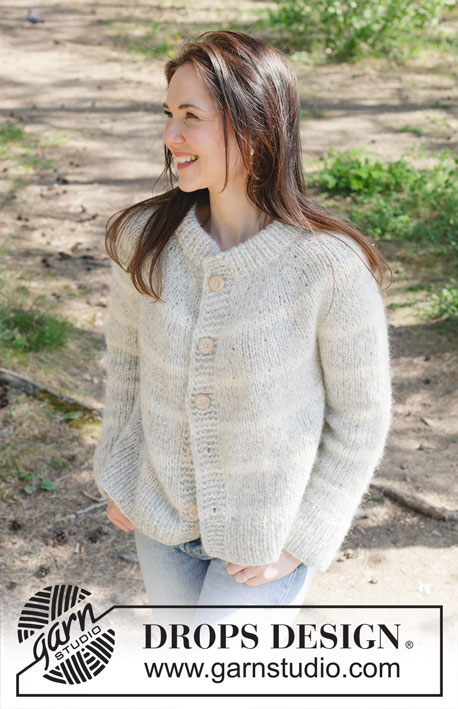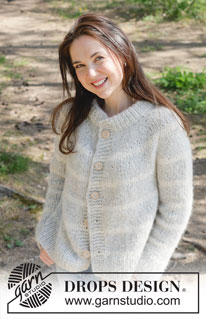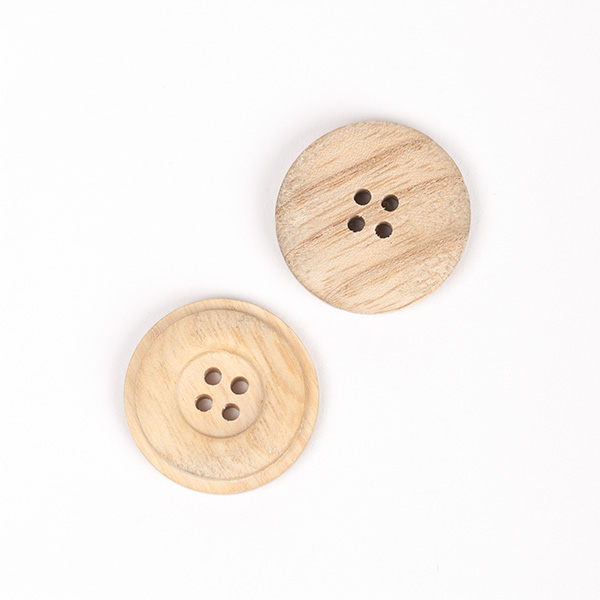Snow Ring Cardigan#snowringcardigan |
|||||||
 |
 |
||||||
Knitted jacket in DROPS Air and DROPS Brushed Alpaca Silk. The piece is worked top down with double neck, round yoke, stripes and split in sides. Sizes S - XXXL.
DROPS 252-35 |
|||||||
|
------------------------------------------------------- EXPLANATIONS FOR THE PATTERN: ------------------------------------------------------- GARTER STITCH (worked back and forth): Knit all rows (from both the right and wrong side). 1 ridge in height = knit 2 rows. BANDS WITH I-CORD BEGINNING OF ROW: Slip 1 stitch purl-wise with strand in front, knit 1, work 5 garter stitches. END OF ROW: Work until there are 7 stitches left on the row, work 5 garter stitches, slip 1 stitch purl-wise with strand in front, knit 1. Work in the same way from both the right and wrong side. BUTTONHOLES: Work the buttonholes on the right band (when garment is worn) from the right side. ROW 1 (right side): Work until there are 5 stitches left on the row, make 1 yarn over, knit 2 together, knit 1, slip 1 stitch purl-wise with strand in front, knit 1. ROW 2 (wrong side): Work the band as before. Knit the yarn over to leave a hole. The first buttonhole is worked on the first row from the right side after the neck is finished. Then work the 4-5-5-5-6-6 other buttonholes with 10-8½-9-9-8-8 cm between each one. The bottom buttonhole is worked in the transition between the stocking stitch and rib. PATTERN: See diagrams A.1 to A.5. The diagrams show the pattern from the right side. STRIPES: Change colour after working the 7 band stitches to avoid loose strands at the front of the jacket. Work with 1 strand DROPS Air and 1 strand DROPS Brushed Alpaca Silk as follows: 2-2-2-2-2-2 cm with colour off white. 6-6-6-7-7-7 cm with colour pearl grey. Repeat these stripes as far as the rib, then finish with 1 strand Air colour pearl grey and 1 strand Brushed Alpaca Silk colour pearl grey. I-CORD: FIRST 2 STITCHES: Worked on all rows: Slip 1 stitch purl-wise, with strand in front, knit 1. LAST 2 STITCHES: Worked on all rows: Work until there are 2 stitches left on the row, slip 1 stitch purl-wise with strand in front, knit 1. INCREASE TIP: Increase 1 stitch by making 1 yarn over, which is worked twisted on the next row/round to avoid a hole. DECREASE TIP: Decrease 1 stitch on each side of the marker-thread as follows: Work until there are 4 stitches left before the marker-thread, knit 2 together, knit 4 (marker-thread is in the middle of these 4 stitches), slip 1 stitch knit-wise, knit 1, pass the slipped stitch over the knitted stitch (= 2 stitches decreased). ------------------------------------------------------- START THE PIECE HERE: ------------------------------------------------------- JACKET – SHORT OVERVIEW OF THE PIECE: The pattern uses both long and short needles; start with the length which fits the number of stitches and change when necessary. The double neck and yoke are worked back and forth with circular needle, from mid front and top down. When the yoke is finished, it is divided for body and sleeves and the body continued back and forth, while the sleeves wait. The body is finally divided for the split in each side and the pieces finished separately back and forth. The sleeves are worked in the round. The neck is folded to the inside and sewn down. If there is a «0» in your chosen size, skip the information and go straight to the next instruction. NECK: Cast on 73-75-79-83-85-89 stitches with circular needle size 8 mm and 1 strand DROPS Air colour pearl grey and 1 strand DROPS Brushed Alpaca Silk colour pearl grey (= 2 strands). Change to circular needle size 5 mm (casting on with a larger needle size makes the cast-on edge elastic). Purl 1 row from the wrong side. Then work as follows from the right side: Work 1 GARTER STITCH – read description above, work rib (knit 1, purl 1) until there are 2 stitches left, knit 1 and 1 garter stitch. Continue this rib for 5 cm (= approx. the height of the neck when folded double). Cast on 6 band stitches at the end of the next 2 rows = 85-87-91-95-97-101 stitches; the outermost 7 stitches are now worked according to BANDS WITH I-CORD, read description above. Work until the neck measures 11 cm – finishing with a row from the wrong side. Insert a marker, inside one of the bands mid-front; the piece is now measured from here. YOKE: Change to circular needle size 8 mm and work the next row from the right side as follows: Work the band as before, stocking stitch until there are 7 stitches left, work the band as before – remember the BUTTONHOLES, read description above = 85-87-91-95-97-101 stitches. Continue with stocking stitch and the bands as before. Remember to maintain the knitting tension. Work until the yoke measures 2-2-3-2-2-2 cm from the marker. Continue as described below, with all increases worked from the right side – read PATTERN above. A.1: Work the band, knit 3-1-6-5-3-2, work A.1, 22-24-22-24-26-28 times (with 9-7-12-11-9-8 stitches left on the row), knit 2-0-5-4-2-1 and work the band = 107-111-113-119-123-129 stitches. Continue with stocking stitch and bands until the yoke measures 7-7-7-7-7-8 cm from the marker. AT THE SAME TIME when the yoke measures 6-6-6-7-7-7 cm from the marker begin working the STRIPES - read description above. A.2: Work the band, knit 3-1-6-5-3-2, work A.2, 22-24-22-24-26-28 times (with 9-7-12-11-9-8 stitches left on the row), knit 2-0-5-4-2-1 and work the band = 129-135-135-143-149-157 stitches Continue with stocking stitch and bands until the yoke measures 12-12-11-12-12-14 cm from the marker. A.3: Work the band, knit 3-1-6-5-3-2, work A.3, 22-24-22-24-26-28 times (with 9-7-12-11-9-8 stitches left on the row), knit 2-0-5-4-2-1, work the band = 151-159-157-167-175-185 stitches Continue with stocking stitch and bands until the yoke measures 17-17-15-17-17-20 cm from the marker. A.4: Work the band, knit 3-1-6-5-3-2, work A.4, 22-24-22-24-26-28 times (with 9-7-12-11-9-8 stitches left on the row), knit 2-0-5-4-2-1, work the band = 173-183-179-191-201-213 stitches. When A.4 is finished, the yoke measures approx. 18-18-16-18-18-21 cm from the marker. In sizes S and M, the increases are finished. In the other sizes increase one more time as described below. Continue with stocking stitch and bands until the yoke measures 18-18-19-22-22-26 cm from the marker. Work as follows from the right side: Work the band, knit 159-169-6-5-3-2, work A.5, 0-0-22-24-26-28 times (with 7-7-12-11-9-8 stitches left on the row), knit 0-0-5-4-2-1 and work the band = 173-183-201-215-227-241 stitches Continue with stocking stitch, stripes and bands. When the yoke measures 20-21-23-24-26-28 cm from the marker mid-front, divide for the body and sleeves. DIVIDE FOR BODY AND SLEEVES: Work the next row as follows: Work 32-33-36-38-41-44 stitches as before (= front piece), place the next 30-32-36-38-39-40 stitches on a thread for the sleeve, cast on 8-10-8-10-12-12 stitches (= in side mid-under the sleeve), work 49-53-57-63-67-73 stitches (= back piece), place the next 30-32-36-38-39-40 stitches on a thread for the sleeve, cast on 8-10-8-10-12-12 stitches (= in side mid-under the sleeve), work the last 32-33-36-38-41-44 stitches as before (= front piece). The body and sleeves are finished separately. BODY: = 129-139-145-159-173-185 stitches. Insert 1 marker-thread in each side, in the middle of the 8-10-8-10-12-12 cast-on stitches under each sleeve. Allow the threads to follow your work onwards; they are used when working the split in each side. Continue back and forth with stocking stitch, stripes and bands as before until the piece measures 41-43-45-46-48-50 cm from the marker mid-front and the next row to be worked from the wrong side: Work as before to 2 stitches before the first marker-thread, place the next 2 stitches on a cable needle behind the piece, purl the next 2 stitches, place the marker-thread on the needle, purl the 2 stitches from the cable needle, work to 2 stitches before the second marker-thread, place the next 2 stitches on a cable needle in front of the piece, purl the next 2 stitches, place the marker-thread on the needle, purl the 2 stitches from the cable needle, work to end of row. Now divide for the split in each side, dividing at each marker-thread; place the back-piece and the right front piece on stitch holders and work the left front piece. LEFT FRONT PIECE: = 36-38-40-43-47-50 stitches. On the next row (= right side) start working rib, AT THE SAME TIME increase 16-18-20-21-23-24 stitches evenly on this row (do not increase across the band) – read INCREASE TIP = 52-56-60-64-70-74 stitches, working as follows: Change to circular needle size 5 mm and work the band as before, work rib (knit 1, purl 1 – remember to increase) until there are 5 stitches left, knit 1 and work 2 GARTER STITCHES – read description above, finish with 2 stitches in I-CORD – read description above. When the rib measures 7-7-7-8-8-8 cm cast off a little loosely with knit over knit and purl over purl. The jacket measures approx. 48-50-52-54-56-58 cm from the marker mid-front and 53-55-57-59-61-63 cm from top of shoulder. RIGHT FRONT PIECE: = 36-38-40-43-47-50 stitches. On the next row (= right side) start working rib, AT THE SAME TIME increase 16-18-20-21-23-24 stitches evenly on this row (do not increase across the band) = 52-56-60-64-70-74 stitches, working as follows: Change to circular needle size 5 mm and work 2 stitches in I-CORD, 2 garter stitches, work rib (knit 1, purl 1 – remember to increase) until there are 8 stitches left, knit 1 and work the band as before. When the rib measures 7-7-7-8-8-8 cm cast off a little loosely with knit over knit and purl over purl. BACK PIECE: = 57-63-65-73-79-85 stitches. Start from the right side and work rib. AT THE SAME TIME, increase 34-36-40-42-46-48 stitches evenly on the first row = 91-99-105-115-125-133 stitches, working as follows: Change to circular needle size 5 mm, work 2 stitches in I-cord, 2 garter stitches, work rib (knit 1, purl 1 – remember to increase), until there are 5 stitches left, knit 1, work 2 garter stitches and 2 stitches in I-cord. When the rib measures 7-7-7-8-8-8 cm, cast off a little loosely with knit over knit and purl over purl. The jumper measures 49-51-53-55-57-59 cm from the marker and approx. 54-56-58-60-62-64 cm from the top of the shoulder. SLEEVES: Place the 30-32-36-38-39-40 sleeve-stitches from one thread on circular needle size 8 mm and knit up 1 stitch in each of the 8-10-8-10-12-12 cast-on stitches under the sleeve = 38-42-44-48-51-52 stitches. Insert 1 marker-thread in the middle of the 8-10-8-10-12-12 new stitches under the sleeve – start at the marker-thread. Work stocking stitch and continue the stripes in the round – AT THE SAME TIME, when the sleeve measures 4-2-2-2-3-2 cm from the division, decrease under the sleeve as follows– read DECREASE TIP: Decrease 2 stitches every 10-6-5-4-3-3 cm a total of 4-6-7-8-9-9 times = 30-30-30-32-32-34 stitches. Continue working until the sleeve measures 37-36-34-33-31-30 cm from the division. Change to double pointed needles size 5 mm and work rib (knit 1, purl 1). AT THE SAME TIME, increase 18-18-18-18-19-20 stitches evenly on the first round = 48-48-48-50-52-54 stitches. When the rib measures 7-7-7-8-8-8 cm cast off a little loosely with knit over knit and purl over purl. The sleeve measures approx. 44-43-41-41-39-38 cm from the division. ASSEMBLY: Fold the neck double to the inside and sew down. To avoid the neck being tight and rolling outwards, it is important the seam is elastic. Sew together the openings on the bands mid-front with small stitches. Sew the buttons onto the left band. |
|||||||
Diagram explanations |
|||||||
|
|||||||

|
|||||||

|
|||||||
Have you finished this pattern?Tag your pictures with #dropspattern #snowringcardigan or submit them to the #dropsfan gallery. Do you need help with this pattern?You'll find 37 tutorial videos, a Comments/Questions area and more by visiting the pattern on garnstudio.com. © 1982-2025 DROPS Design A/S. We reserve all rights. This document, including all its sub-sections, has copyrights. Read more about what you can do with our patterns at the bottom of each pattern on our site. |
|||||||


























































































Post a comment to pattern DROPS 252-35
We would love to hear what you have to say about this pattern!
If you want to leave a question, please make sure you select the correct category in the form below, to speed up the answering process. Required fields are marked *.